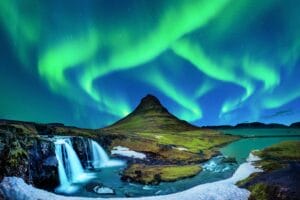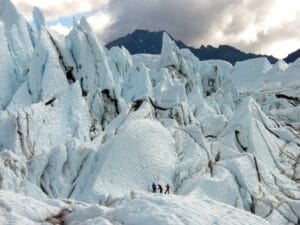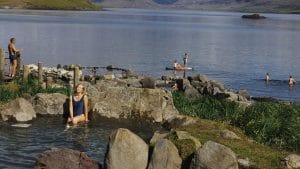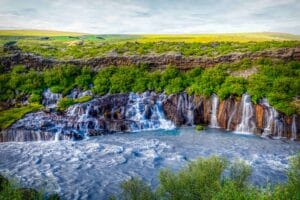October is one of the most magical times of year to visit Iceland. The landscapes are bathed in the vibrant colors of autumn, the Northern Lights start to appear more frequently, and the tourist crowds are smaller, making it an ideal time for exploration. Whether you’re coming for the natural beauty, cultural experiences, or outdoor adventures, Iceland in October offers a perfect mix of all of these. Let’s dive into everything you need to know about visiting Iceland during this unique month.
Why Visit Iceland in October?
Visiting Iceland in October offers several distinct advantages:
- Fewer Crowds: October is considered the shoulder season, meaning fewer tourists compared to the busy summer months. You’ll have more space to explore popular destinations like Golden Circle, Blue Lagoon, and Reykjavik without the usual crowds.
- Northern Lights: October marks the beginning of the Northern Lights season, with longer nights and clearer skies providing optimal conditions for aurora viewing.
- Autumn Colors: Iceland’s landscapes take on a whole new level of beauty in autumn, with golden foliage, moss-covered lava fields, and snow-capped mountains. The contrast of fall colors against the dark volcanic terrain is breathtaking.
- Mild Weather: Although cooler than summer, October weather is generally milder compared to the freezing winter months, making it comfortable for outdoor activities like hiking, sightseeing, and exploring waterfalls.
- Unique Activities: From hot springs to ice caves and seasonal festivals, October offers plenty of unique things to do that highlight the best of Iceland.
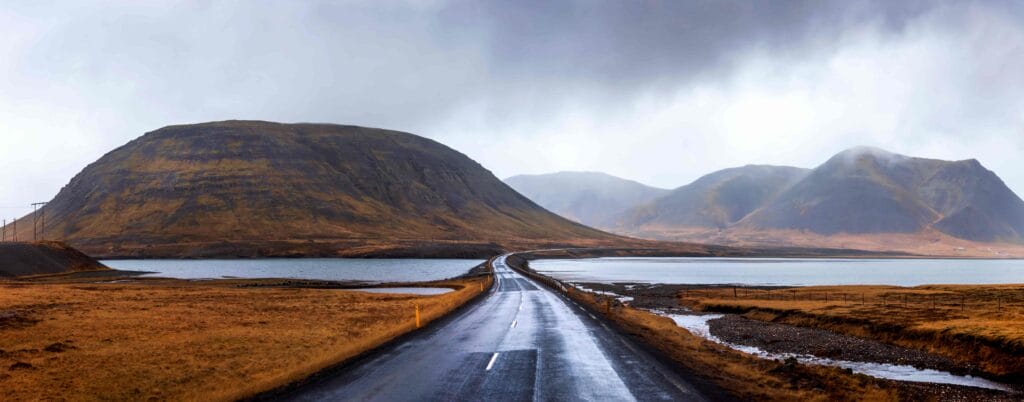
Weather in Iceland in October
October is a transitional month in Iceland, as the country shifts from the relatively mild summer to the colder winter season. The weather can be unpredictable, but it’s part of the charm of visiting Iceland.
Temperature
Average temperatures in October range from 2°C to 7°C (35°F to 45°F), with coastal areas like Reykjavik being slightly warmer than inland locations.
Rain & Wind
October can be quite wet and windy, so it’s important to be prepared for rain showers and strong gusts. However, these conditions also create dramatic landscapes and can make Iceland feel even more wild and untamed.
Daylight Hours
October sees around 8-10 hours of daylight, which is plenty of time for sightseeing, but also gives you the chance to witness the Northern Lights in the evenings.

Pros and Cons of Visiting Iceland in October
Here’s a detailed list of the pros and cons of visiting Iceland in October to help you decide if this is the right time for your trip:
Pros of Visiting Iceland in October
1. Northern Lights Season Begins
Pro: October is one of the best months to see the Northern Lights. With longer nights and generally clear skies, you have a higher chance of witnessing the aurora borealis in action. Plus, it’s easier to avoid crowds while chasing the lights compared to peak winter months like December or January.
2. Fewer Tourists
- Pro: October is part of the shoulder season, meaning fewer tourists compared to the busy summer months. You’ll enjoy popular attractions like the Golden Circle, Blue Lagoon, and Seljalandsfoss with fewer crowds, giving you a more intimate experience with nature.
3. Autumn Colors
- Pro: The autumn foliage in Iceland is spectacular, with the landscape transforming into shades of gold, orange, and brown. This creates beautiful contrasts against the dark volcanic terrain and glaciers, making it an excellent time for photography.
4. Comfortable Weather for Outdoor Activities
- Pro: While cooler than summer, the weather in October is still relatively mild compared to the harsh winter months. Average temperatures range from 2°C to 7°C (35°F to 45°F), making it comfortable for outdoor activities like hiking, sightseeing, and exploring waterfalls.
5. Off-Season Prices
- Pro: Since October is the off-season, many accommodations, tours, and flights offer lower prices than during the peak summer season. This means you can save money while still enjoying a fantastic Icelandic adventure.
6. Unique Experiences
- Pro: October is a transitional month, offering access to both summer and winter activities. You can still hike in places like Landmannalaugar, which may close as the season progresses, while also exploring the first ice caves and glaciers opening up for the winter.
Cons of Visiting Iceland in October
1. Unpredictable Weather
- Con: Iceland’s weather in October can be unpredictable. You may experience a mix of rain, wind, and cold temperatures throughout your trip, which can sometimes make outdoor activities more challenging. Be prepared for rapid changes in weather and pack accordingly.
2. Shorter Daylight Hours
- Con: In October, daylight hours are shorter, with around 8-10 hours of sunlight per day. This means you’ll need to plan your activities carefully, especially if you’re driving long distances or exploring remote areas. However, this is balanced by longer nights, which are ideal for seeing the Northern Lights.
3. Limited Accessibility to Highland Roads
- Con: Many of Iceland’s highland roads (F-roads) start closing in mid to late October as winter approaches. This means access to some remote destinations, like parts of the interior highlands, becomes limited. If you’re planning to visit Landmannalaugar or other highland areas, it’s best to go early in the month or join a guided tour with a Super Jeep.
4. Rainy Days
- Con: October tends to be one of the rainier months in Iceland. While the rain can add to the dramatic beauty of waterfalls and landscapes, it may also limit visibility for scenic drives or outdoor photography.
5. Fewer Summer Activities
- Con: If you’re hoping to enjoy summer-specific activities like whale watching (which is best from April to September), or if you want access to all highland hiking trails, October may not be ideal as some activities begin to wind down. However, many autumn and winter activities, like ice caving and glacier hiking, begin to ramp up.
6. Icy Roads
- Con: Early frost and occasional snow can create icy road conditions, especially in the evenings or in higher elevations. Driving can be more challenging in these conditions, so it’s important to exercise caution and be prepared for potentially slippery roads.
Visiting Iceland in October is perfect for travelers who want to experience the beauty of autumn, chase the Northern Lights, and explore Iceland with fewer crowds. It’s an ideal time for those who enjoy off-season travel and don’t mind unpredictable weather. On the flip side, if you prefer longer days, guaranteed summer activities, or access to all highland roads, October might not offer everything you’re looking for.
By planning your itinerary carefully and packing appropriately for the weather, you’ll be able to enjoy a memorable adventure in Iceland, filled with autumn colors, dramatic landscapes, and the possibility of seeing the magical Northern Lights.
Best Things to Do in Iceland in October
October offers a wide range of activities, from chasing the Northern Lights to enjoying scenic hikes and cultural festivals. Here are some of the top things to do:
1. Northern Lights Hunting

One of the main reasons people visit Iceland in October is to catch a glimpse of the Northern Lights (Aurora Borealis). October’s long nights and relatively clear skies make it a great time for aurora viewing. To increase your chances of seeing them:
- Head to remote areas away from city lights, like Thingvellir National Park, Vik, or the Westfjords.
- Join a Northern Lights Tour: Many tours offer expert guides and special vehicles to take you to the best viewing spots. Check out Iceland Travel Guide’s Northern Lights tours for options.
- Check the Aurora Forecast: The Icelandic Met Office provides real-time aurora forecasts to help you know when the lights are most likely to appear.
2. Explore Iceland’s Waterfalls

Iceland is known for its stunning waterfalls, and October is a great time to visit them. The added rainfall from autumn often makes the waterfalls even more powerful. Some must-see waterfalls include:
- Seljalandsfoss: This waterfall is famous for its path that allows you to walk behind the falls, giving you a unique perspective.
- Skógafoss: One of Iceland’s largest waterfalls, Skógafoss is even more dramatic with the autumn backdrop and the possibility of rainbows forming in its mist.
- Gullfoss: Located on the popular Golden Circle, this massive waterfall is a must-see, especially with the fall colors surrounding it.
3. Visit Geothermal Hot Springs

As the temperatures drop in October, there’s nothing quite like soaking in a geothermal hot spring surrounded by Iceland’s breathtaking natural beauty. Iceland is home to several unique hot springs, each offering a different kind of experience. Whether you’re seeking luxury, adventure, or something off the beaten path, there’s a perfect geothermal spot for you.
Blue Lagoon
This world-famous geothermal spa is a luxurious way to relax after a day of sightseeing. The mineral-rich waters are known for their soothing and healing properties, and the iconic milky blue color makes for stunning photographs. October is a great time to visit the Blue Lagoon as the summer crowds have decreased, giving you more space to unwind in its tranquil waters.
Secret Lagoon
Located near the Golden Circle, the Secret Lagoon offers a more natural, rustic experience compared to the Blue Lagoon. Its surroundings retain an old-world charm, with steaming hot springs bubbling nearby. The water is geothermally heated, making it perfect for a warm soak in cooler autumn weather. It’s a quieter alternative that lets you enjoy the Icelandic wilderness in peace.
Sky Lagoon
One of Iceland’s newest luxury hot springs, the Sky Lagoon, is a must-visit for a premium spa experience. Located on the outskirts of Reykjavik, this geothermal retreat is perched on the edge of the ocean, offering breathtaking views of the North Atlantic while you soak in the warm, mineral-rich waters. The 7-step ritual at Sky Lagoon, which includes a cold plunge and a sauna with panoramic views, makes it a standout. Visiting in October, you may even catch a glimpse of the Northern Lights dancing above while you relax.
Hvammsvik Hot Springs
For a more off-the-beaten-path geothermal experience, head to Hvammsvik Hot Springs, located in the scenic Hvalfjörður fjord. Surrounded by untouched nature, Hvammsvik is made up of several natural pools that blend seamlessly into the landscape. Here, you can experience Iceland’s geothermal energy in its most authentic form. The mix of hot and cold springs, combined with the beauty of the fjord, makes Hvammsvik a hidden gem perfect for a peaceful autumn day. Like Sky Lagoon, October offers the chance to see the Northern Lights while enjoying a quiet soak.
Reykjadalur Hot Springs
For a more adventurous soak, hike through the Reykjadalur valley to reach these natural hot springs. The hike takes about an hour and offers stunning views along the way, with steam rising from the ground as you approach the geothermal river. Once there, you can relax in the naturally heated waters surrounded by the rugged beauty of Iceland’s landscape. It’s a perfect spot for those who enjoy combining hiking with a rewarding hot spring dip.
4. Join a Glacier Hiking or Ice Caving Tour

October is a perfect time for glacier hiking as the temperatures are still mild but the glaciers are less crowded. Many tours take you to Sólheimajökull or Vatnajökull for an unforgettable adventure across the icy terrain.
- Glacier Hiking: Strap on your crampons and explore the glacier with a guide. You’ll traverse crevasses, ice ridges, and frozen landscapes, all while learning about the glacier’s history and formation.
- Ice Caving: By the end of October, some ice caves start opening up for the season. These caves, formed by glacial melt, are stunning with their bright blue ice and intricate formations. Visiting an ice cave is a truly magical experience, and it’s something that only exists for a short window of time each year.
5. Attend Icelandic Cultural Events and Festivals

October also brings with it a few exciting cultural events that allow you to experience the local side of Iceland. Some events to look out for include:
- Iceland Airwaves (early November, but worth planning for if your trip overlaps): This world-famous music festival showcases Icelandic and international artists in venues around Reykjavik.
- Reykjavik International Film Festival (RIFF): This annual festival runs through early October and celebrates independent filmmaking from around the world.
- Halloween in Iceland: Although not traditionally an Icelandic holiday, Halloween has grown in popularity, especially in Reykjavik, where you’ll find themed parties, events, and even trick-or-treating in some neighborhoods.
6. Whale Watching

Most migrating animals and birds including many species of whales and dolphins already start to swim away from their migrating zones to the north in September but there is still a fair chance that you will be able to catch a sight of these magnificent creatures on your trip to the black sand beach. Minks, humpbacks and dolphins are commonly spotted from Reykjavík. If traveling to Akureyri, you have a chance to get a sneak peek at belugas and even narwhals which are spotted from time to time in the city. If you are a wildlife enthusiast it is recommended that you book a special boat ride for whale watching. However, if you are not able to spot any whales or dolphins on your trip, most of the touring companies let you reuse your ticket for another ride later whenever you desire.
Best Self Drive Activities in Iceland in October

Driving in Iceland in October
If you plan to rent a car and explore on your own, October is still a manageable time to drive in Iceland. However, it’s important to be aware of road conditions:
- Icy Roads: Some inland roads may already have snow and ice, especially early in the morning and at night. Make sure your rental car is equipped with winter tires.
- F-Road Closures: Many of the highland F-roads start to close in mid to late October as snow begins to fall. Check road conditions regularly on the Icelandic Road and Coastal Administration website before setting out on any journeys.
- Shorter Daylight Hours: Plan your day’s itinerary carefully to make the most of the available daylight. Be mindful of driving in the dark, especially on remote roads.
Best Multi Day Tours to Take in Iceland in October

What to Pack for Iceland in October
Packing smartly is essential when visiting Iceland in October, as the weather can change quickly. Here’s a list of must-haves:
- Warm Layers: Start with a thermal base layer, then add an insulating layer like fleece or wool. Top it off with a waterproof and windproof jacket to protect you from the elements.
- Waterproof Pants: These are a lifesaver if you’re planning on hiking or visiting waterfalls. Iceland’s weather can be unpredictable, and waterproof pants will keep you dry and comfortable.
- Sturdy Waterproof Hiking Boots: Whether you’re hiking or just walking around sightseeing, waterproof hiking boots with good grip are essential for navigating Iceland’s varied terrain.
- Hat, Gloves, and Scarf: The wind can feel especially chilly in October, so be sure to pack these accessories to stay warm.
- Swimsuit: You’ll want to take advantage of Iceland’s famous hot springs and geothermal pools like the Blue Lagoon and Secret Lagoon, even in cooler weather.
- Camera: October is one of the best times to photograph Iceland’s stunning landscapes and the Northern Lights. A good camera (preferably with manual settings) will help you capture those magical moments.
Visiting Iceland in October offers a unique blend of autumn beauty, fewer crowds, and magical experiences that.













